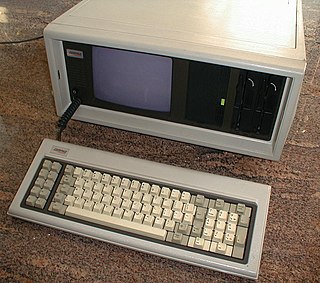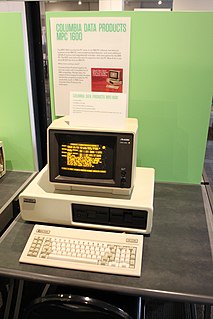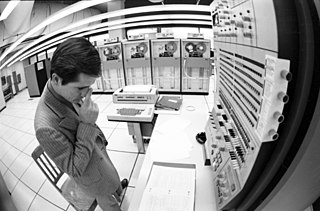Related Research Articles

The Apple II is an 8-bit home computer and one of the world's first highly successful mass-produced microcomputer products. It was designed primarily by Steve Wozniak; Steve Jobs oversaw the development of Apple II's foam-molded plastic case and Rod Holt developed the switching power supply. It was introduced by Jobs and Wozniak at the 1977 West Coast Computer Faire, and marks Apple's first launch of a personal computer aimed at a consumer market—branded toward American households rather than businessmen or computer hobbyists.

The IBM Personal Computer is the first microcomputer released in the IBM PC model line and the basis for the IBM PC compatible de facto standard. Released on August 12, 1981, it was created by a team of engineers and designers directed by Don Estridge in Boca Raton, Florida.

The TRS-80 Micro Computer System is a desktop microcomputer launched in 1977 and sold by Tandy Corporation through their Radio Shack stores. The name is an abbreviation of Tandy Radio Shack, Z80 [microprocessor]. It is one of the earliest mass-produced and mass-marketed retail home computers.

IBM PC compatible computers are similar to the original IBM PC, XT, and AT that are able to use the same software and expansion cards. Such computers were referred to as PC clones, or IBM clones. The term "IBM PC compatible" is now a historical description only, since IBM no longer sells personal computers after it sold its personal computer division in 2005 to Chinese technology company Lenovo. The designation "PC", as used in much of personal computer history, has not meant "personal computer" generally, but rather an x86 computer capable of running the same software that a contemporary IBM PC could. The term was initially in contrast to the variety of home computer systems available in the early 1980s, such as the Apple II, TRS-80, and Commodore 64. Later, the term was primarily used in contrast to Apple's Macintosh computers.

The Atari 8-bit family is a series of 8-bit home computers introduced by Atari, Inc. in 1979 as the Atari 400 and Atari 800. The series was successively upgraded to Atari 1200XL, Atari 600XL, Atari 800XL, Atari 65XE, Atari 130XE, Atari 800XE, and Atari XEGS, the last discontinued in 1992. They differ primarily in packaging, each based on the MOS Technology 6502 CPU at 1.79 MHz and the same custom coprocessor chips. As the first home computer architecture with coprocessors, it has graphics and sound more advanced than most contemporary machines, and great appeal for games. First-person space combat simulator Star Raiders is considered the platform's killer app. The plug-and-play peripherals use the Atari SIO serial bus, with one developer eventually also co-patenting USB.

Xenix is a discontinued version of the Unix operating system for various microcomputer platforms, licensed by Microsoft from AT&T Corporation in the late 1970s. The Santa Cruz Operation (SCO) later acquired exclusive rights to the software, and eventually replaced it with SCO UNIX.
Computer magazines are about computers and related subjects, such as networking and the Internet. Most computer magazines offer advice, some offer programming tutorials, reviews of the latest technologies, and advertisements.

CP/M-86 was a version of the CP/M operating system that Digital Research (DR) made for the Intel 8086 and Intel 8088. The system commands are the same as in CP/M-80. Executable files used the relocatable .CMD file format. Digital Research also produced a multi-user multitasking operating system compatible with CP/M-86, MP/M-86, which later evolved into Concurrent CP/M-86. When an emulator was added to provide PC DOS compatibility, the system was renamed Concurrent DOS, which later became Multiuser DOS, of which REAL/32 is the latest incarnation. The FlexOS, DOS Plus, and DR DOS families of operating systems started as derivations of Concurrent DOS as well.

Columbia Data Products (CDP) is a company which produced the first legally reverse-engineered IBM PC clones. It faltered in that market after only a few years, and later reinvented itself as a software development company.

Popular Electronics was an American magazine published by John August Media, LLC, and hosted at TechnicaCuriosa.com. The magazine was started by Ziff-Davis Publishing Company in October 1954 for electronics hobbyists and experimenters. It soon became the "World's Largest-Selling Electronics Magazine". In April 1957 Ziff-Davis reported an average net paid circulation of 240,151 copies. Popular Electronics was published until October 1982 when, in November 1982, Ziff-Davis launched a successor magazine, Computers & Electronics. During its last year of publication by Ziff-Davis, Popular Electronics reported an average monthly circulation of 409,344 copies. The title was sold to Gernsback Publications, and their Hands-On Electronics magazine was renamed to Popular Electronics in February 1989, and published until December 1999. The Popular Electronics trademark was then acquired by John August Media, who revived the magazine, the digital edition of which is hosted at TechnicaCuriosa.com, along with sister titles, Mechanix Illustrated and Popular Astronomy.

PC Magazine is an American computer magazine published by Ziff Davis. A print edition was published from 1982 to January 2009. Publication of online editions started in late 1994 and have continued to the present day.

Creative Computing was one of the earliest magazines covering the microcomputer revolution. Published from October 1974 until December 1985, the magazine covered the spectrum of hobbyist/home/personal computing in a more accessible format than the rather technically oriented Byte.
HERO is a series of several educational robots sold by Heathkit during the 1980s. The Heath Company began the HERO 1 project in October 1979, with the first release in 1982. Models include the HERO 1, HERO Jr., and HERO 2000. Heathkit supported the HERO robot line until 1995. All three were produced as kits, or for more money, prebuilt by Heathkit. The 1980s models are considered collectors items, due to their rarity. For the most part, they cannot perform practical tasks, but are more geared toward entertainment and education above all.

Legionnaire is a computer wargame for the Atari 8-bit series created by Chris Crawford in 1982, and released through Avalon Hill. Recreating Julius Caesar's campaigns in a semi-historical setting, the player takes command of the Roman legions in real-time battles against the barbarians.

Elektor, also known as Elektor Magazine, is a monthly magazine about all aspects of electronics, originally published in the Netherlands as Elektronica Wereld in 1961 and latterly Elektuur in 1964, and now published worldwide in many languages including English, German, Dutch, French, Greek, Spanish, Swedish, Portuguese and Italian with distribution in over 50 countries. The English language edition of Elektor was launched in 1975 and is read worldwide.

The history of the personal computer as a mass-market consumer electronic device began with the microcomputer revolution of the 1970s. A personal computer is one intended for interactive individual use, as opposed to a mainframe computer where the end user's requests are filtered through operating staff, or a time-sharing system in which one large processor is shared by many individuals. After the development of the microprocessor, individual personal computers were low enough in cost that they eventually became affordable consumer goods. Early personal computers – generally called microcomputers – were sold often in electronic kit form and in limited numbers, and were of interest mostly to hobbyists and technicians.
This article presents a timeline of events in the history of 16-bit x86 DOS-family disk operating systems from 1980 to present. Non-x86 operating systems named "DOS" are not part of the scope of this timeline.

The High-Performance Graphics Display Controller 7220 is a video display processor capable of drawing lines, circles, arcs, and character graphics to a bit-mapped display. It was developed by NEC in order to support the Kanji character set efficiently, which explains why the APC computer line had superior graphics compared to competing models. The chip was first used in the NEC N5200 and in later computers, such as the NEC PC-9801, APC II and APC III computers, the NECcomputer, the optional graphics module for the DEC Rainbow, the NCR Decision Mate V, the Tulip System-1, and the Epson QX-10.

Byte was a microcomputer magazine, influential in the late 1970s and throughout the 1980s because of its wide-ranging editorial coverage.
The Byte Sieve is a computer-based implementation of the Sieve of Eratosthenes published by Byte as a programming language performance benchmark. It first appeared in the September 1981 edition of the magazine and was revisited on occasion. Although intended to compare the performance of different languages on the same computers, it quickly became a widely used machine benchmark.
References
- ↑ Ciarcia, Steve (November 1982). "Build the Circuit Cellar MPX-16 Computer System". BYTE. p. 78. Retrieved 19 October 2013.
- ↑ Ciarcia, Steve (December 1982). "Build the Circuit Cellar MPX-16 Computer System / Part 2". BYTE. p. 42. Retrieved 19 October 2013.
- ↑ Ciarcia, Steve (January 1983). "Build the Circuit Cellar MPX-16 Computer System / Part 3". BYTE. p. 54. Retrieved 19 October 2013.
- ↑ "Circuit Cellar - the Magazine for Computer Applications". Archived from the original on 2011-09-27. Retrieved 2010-01-07.
- ↑ Ciarcia Onward and Upward; Circuit Cellar; November 26, 2012.